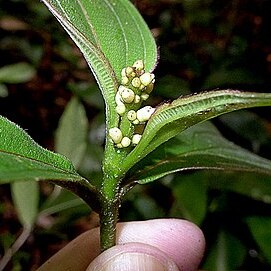Shrub to 6 m. tall, the younger stems, petioles, panicle, and primary nerves of the leaves densely strigose; petioles 1-2 cm. long; leaf-blades thin, elliptic or oblong, up to 25 cm. long, a third to half as wide, often unequal in each pair, acuminate or rarely acute, entire or nearly so, long-cuneate at the base, 5-to 7-pli-nerved, the inner pair of lateral nerves arising 2-8 cm. from the base, sparsely pubescent on the upper surface, softly pubescent or subsericeous on the lower; panicle commonly elongate, 5-15 cm. long, the flowers mostly sessile in lateral glomerules, occasionally on short lateral branches; hypanthium narrowly cam-panulate, 3.5-4 mm. long, densely strigose; calyx-tube about 0.5 mm. long; sepals minute, triangular; petals white, oblong-obovate, 3-3.5 mm. long; stamens isomorphic; anthers linear, straight, 3.5-4 mm. long, the connective prolonged straight back into a single dorsal appendage 0.2-0.3 mm. long; ovary pubescent; style about 6 mm. long; stigma truncate.
More
A shrub. It grows 5 m tall. The leaves are covered with soft hairs. The leaves are greyish green underneath. The flowering groups are bright orange and at the ends of branches. The flowers are small and white. The fruit is a purple spongy berry. It is 1 cm across.

